
Ease of Use
April 2009
Xerox WorkCentre 4260 XF
www.BERTL.com
Copyright © 2009 BERTL Inc.
April 2009
All Rights Reserved. The license under which this document is made available and applicable law prohibit any reproduction or further transmission of any portion of this document. This
document may only be viewed electronically through the www.BERTL.com Web site and may not be stored in electronic or hard copy format. Any reproduction of trademarks is strictly
prohibited. BERTL accepts no responsibility for any inaccuracies or omissions contained in this document.
Page 28
Above and below:
This tab provides print-driver version
information.
The WorkCentre 4260 device supports two innovative new print
drivers that can greatly simplify installing, managing and
supporting printers and multifunction devices on the network, and
increase end-user productivity:
Xerox Global Print Driver (X-GPD) is a truly universal print driver
that lets IT administrators install, upgrade and manage Xerox and
non-Xerox devices from a single driver. It provides a consistent,
easy-to-use interface for end-users, aimed at reducing the
number of support calls, and simplifying print services
management.
The Xerox Mobile Express Driver (X-MED) makes it easy for
mobile users to find, use and manage Xerox and non-Xerox
devices in every new location. Users can plug into a new network,
and the X-MED driver will automatically discovers available
printers and provide status and capability information. Users can
save a list of “favorite” printers for each location, store application
print settings for use on any printer in any network, and greatly
reduce mobile support calls to IT administrators.
In addition, these drivers provide users with a consistent single
interface for all printers, with real-time, dynamic reports of printer
status. As a result, users can easily identify the best printer for
their needs, quickly choose the correct options and see updated
consumables status without the assistance of IT.
ROUTINE MAINTENANCE
Workgroup devices sold through retail and traditional IT
distribution outlets usually are maintained by office workers
who change the all-in-one cartridge units that encase the
entire imaging system, including the toner cartridge (or the
ink cartridges employed by ink-jet imaging systems). Units
sold through resellers and dealers are usually maintained
by office workers and/or trained service engineers. While
separate long-life parts are more complex to install (i.e.,
separate toner cartridges, imaging drums, transfer belts),
they tend to cost less than low- yield, all-in-one
alternatives.
Toner or Ink Replacement
Changing the toner, imaging cartridge or ink cartridge is a
necessary task that is traditionally is avoided by some for
fear of toner dust or ink leaking on clothing or hands, or the
fear that it might be too complicated. However, most units
today offer clean replacement of toner or ink supplies, and
there is very little risk of toner or ink leakage. Usually the
replacement process is usually easy.
Clearing Media Misfeeds
The main issue that office users attempt to avoid is the
removal of an occasional media misfeed. As a general
rule, the faster a device engine, and the more media
handling and finishing options it has, the more complex is
the process of removing media misfeeds.
Common media-misfeed sources involve the duplex unit
and poor loading of media supplies. The position of the
duplex unit may be a major factor in the removal of many














































